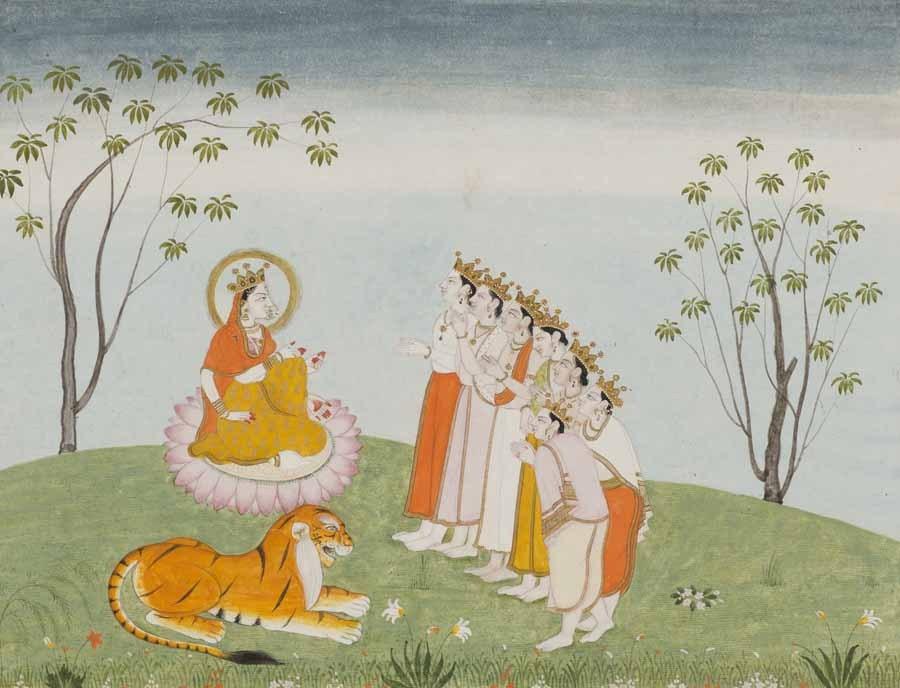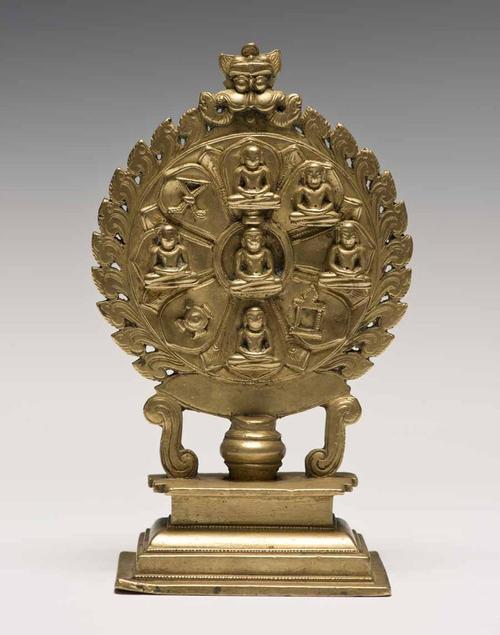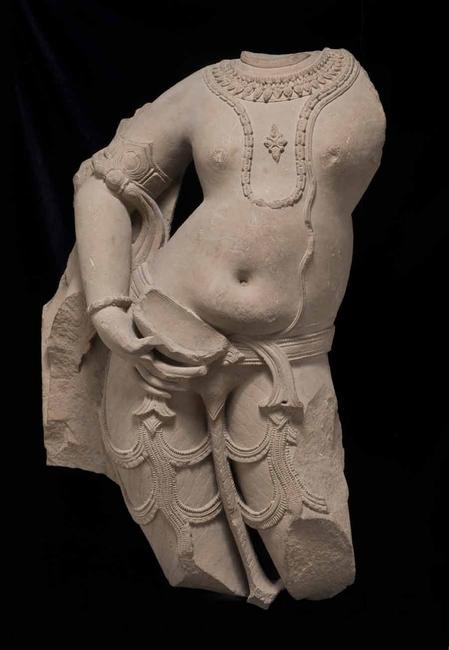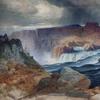Puja and Piety: Hindu, Jain, and Buddhist Art from the Indian Subcontinent
- SANTA BARBARA, California
- /
- February 24, 2016

This exhibition is the first in North America to celebrate the diversity of South Asian art by examining the relationship between aesthetic expression and the devotional practice, or puja, in the three native religions of the Indian subcontinent. As one of the major presentations of the Santa Barbara Museum of Art’s (SBMA) 75th-anniversary year in 2016, Puja and Piety showcases one of the areas of the Museum’s Asian Art holdings that has expanded the most in recent years. Drawn primarily from SBMA’s permanent collection and augmented by loans from regional, private lenders who are longtime friends and patrons of the Museum, the exhibition presents more than 160 objects of diverse media created over the past two millennia for temples, home worship, festivals, and roadside shrines. From monumental painted temple hangings to portable pictures for pilgrims, from stone sculptures to processional bronzes and wooden chariots, from ancient terracottas to various devotional objects for domestic shrines, this exhibition aims to examine and provide contextualized insights for both classical and popular works of art.

The Indian subcontinent today consists of three sovereign nations: India, Bangladesh, and Pakistan. While the two latter countries are predominantly Islamic, in the past they too had large populations practicing the three principal religions―Hinduism, Jainism, and Buddhism―that originated in the subcontinent. In India, Hinduism and Jainism continue to be vibrant traditions, while Buddhism is enjoying a revival after disappearing from its homeland centuries ago, though with wide reception throughout Asia and other parts of the world. Through the integration of contemporary photographs and videos of private worship and public rituals with art, this exhibition demonstrates that the primary function of the objects was not simply to be exhibited as mute expressions of the unknown artist, but as material embodiments of the divine with which to interact both emotionally and spiritually.
While the three native religions are renowned for their profound philosophical speculations, it is the beliefs and rituals of these religions, and their existence as living faiths, which are the focal points of the exhibition. Puja is the devotional act of worshipping a god or a deified teacher through invocations, prayers, songs, and rituals. Through puja, the devotee aims to make a spiritual connection with the divine. This contact is commonly facilitated through an object, whether it is an element from nature or an image in the form of a painting, sculpture, or print. While there are textural and philosophical differences, all three native religions share the same spiritual goals of seeking release from the endless cycle of earthly rebirth and achieving a transcendental state known as moksha or nirvana. Individuals from varying levels of society—the patron, the artist, and the worshippers—collectively created the works of religious devotion shown in this exhibition.

Hinduism
Hinduism is an ancient religion with many sects, all of which trace their origins to the self-revealed text known as Vedas. Its beliefs and practices evolved over time, featuring many gods and goddesses, all of whom are personifications of an immense incomprehensible force that governs all existence. In practice, most Hindu devotees worship selected gods that they believe affect the wellbeing of their daily lives. By paying reverence and conducting the designated puja, they strive to experience unity with that transcendental cosmic force.
There are three primary Hindu deities, Shiva (creator and destroyer), Vishnu (the preserver), and Devi (the Mother Goddess). All of them appear in different forms to create, preserve, and destroy the universe in an endlessly repeating cycle. Devi is identified as the creative energy of the universe (Shakti) who epitomizes power―as a gentle loving wife and mother and the fierce destroyer of evil. She is known by many names, including Parvati (Shiva’s consort), Lakshmi (Vishnu’s consort), and Durga and Kali, the multi-limbed, militant warrior goddesses.
Hindu temples are utilized as meeting places that house primary images, as opposed to places of congregation with formalized preachers, sermons, or audiences. While the sandstone sculpture (above left) was carved for the wall of a Vishnu temple in north India, the granite sculpture (above center) was likely used in a Southern temple dedicated to Shiva who is portrayed as, according to Stephen Huyler in his essay in the accompanying exhibition catalogue, “… God at his most peaceful—the explosive power of the universe gracefully contained in pure balance within his state of yogic bliss.”
In addition, large processional objects, such as the cart of Vishnu, were created for temple festival processions, while other images were created for pilgrims and private use, such as the late 19th-century painting Goddess Kali, a Manifestation of Devi (Great Goddess) from Kolkata, West Bengal.
Jainism and Buddhism
Unlike Hinduism, which derives its authority from ancient scriptures of unknown origin, Jainism and Buddhism owe their origins to known historical founders. They were considered reformists in reaction to the strict control of the priestly class in Hindu society. Jainism is the older of the two religions, its followers focusing on the teachings of a series of 24 enlightened and liberated teachers called Jina (victor), the last of whom, Mahavira (6th–5th century BCE), is regarded as the founder. Jain prescribes a path of non-violence and self-discipline. Through ascetic purification of the mind and body, it is believed that one can reach the spiritual goal of release. Mahavira’s younger contemporary, Buddha Sakyamuni, advised against such an extreme lifestyle and recommended moderation, known as the middle path. Neither asserted the existence of god, but in time, both religions evolved a rich mythology and pantheon, sharing similar ideas as well as rituals with Hinduism.
Followers of Jainism adhere to the teachings of Mahavira in two ways. As explained by John Cort in his essay “A small minority choose to follow the example of the Jinas and renounce the world, becoming possessionless and homeless monks and nuns. Their spiritual lives are marked by extreme vegetarian dietary restrictions in order to effect as little harm in the world as possible… Most Jains, however, choose not to follow this heroic spiritual path, and instead remain in the world as householders…They improve their spiritual status through venerating and providing material support to the monks and nuns, and by worshipping the spiritual ideal represented by the Jinas.”
Many of the Jain items in the exhibition were originally used in homes for private worship. They are images of Jina or a Jain saint (left), either seated in meditation or standing in a “body abandonment posture,” an erect immobile posture with arms hanging free from the body, which is considered a form of severe asceticism.
Other devotional items were used in temples and private homes, such as mandala images in sculpture or scenes depicting important shrines, such that of Shatrunjaya ―the sacred mountain that for the past millennium has been the most important pilgrimage destination for devotees. According to Cort, “Every year, a large festival is held at the end of the rainy season, when the mountain is opened again to pilgrims who can climb it without harming the many minute organisms that generate during the monsoon rains. For those Jains who cannot travel to Shatrunjaya, large paintings of the shrine are displayed at temples and other Jain institutions, so that they can come and worship the shrine in its local incarnation.”
Conversely, the ultimate goal of Buddhism, as explained by Christian Luczanits in the exhibition catalogue, “…is the attainment of awakening (bodhi), and with it the release from the cycle of rebirth (samsara).” However, the paths leading to this awakening are long and difficult, and not suited for everyone. Therefore, most Buddhists take a gradual approach towards enlightenment, expecting to improve their conditions over several lives. On the most basic level, piety and puja are both means of this gradual approach, practiced on a daily basis in both private and public. Like Hinduism, Buddhism also developed a pantheon of divinities, most notably bodhisattvas—enlightened beings who postponed their own release into nirvana to remain on earth to help others.
Due to its wide reception throughout Asia and its practical disappearance from its homeland in northern India, Buddhism is presented in this exhibition and catalogue through the historical context of its Indian heritage, supplemented with examples of its practice in the neighboring regions of Nepal and Tibet in order to reconstruct the practices as they have developed in India.
The earliest sculptures in the exhibition are fine examples of some of the first appearances of Buddha in an aniconic form of a garlanded Bodhi Tree or a birth scene on a fragment of the frieze from a stupa in Nagarjunakonda (above left). Images of Buddha in his earliest human form found in the Mathura and Gandhara regions from the 1st to the 4th centuries are also on display with varied regional styles from flourishing Buddhist centers.
During the middle of the first millennium, a newly established esoteric Buddhist practice first became apparent, in which deities became both increasingly functional and symbolic, depending on the needs of the people.
This votive plaque (left) was likely produced in mass, also indicative of another characteristic of esoteric Buddhist practice. According to Luczanits, “Vajrayana (esoteric) worship often involves the repetition of the same tasks, such as the performance of prostrations or the pronunciation of mantras over an extended period. The votive plaques are the material equivalent of these practices, commonly reproduced not to be worshipped but to fill the hollow spaces of a stupa as relics of the Buddhist teachings.
Catalogue
Featuring an introduction by the eminent art historian and curator Pratapaditya Pal; accessible essays on each religious tradition by John E. Cort, Stephen P. Huyler, and Christian Luczanits; and map, historical timeline, and glossary by Debashish Banerji; this richly illustrated catalogue provides a lasting resource for readers interested in South Asian art and spirituality. Published by Santa Barbara Museum of Art in association with University of California Press.
This exhibition is organized by Susan Tai, SBMA’s Elizabeth Atkins Curator of Asian Art, in collaboration with Pratapaditya Pal, guest curator and editor of the catalogue.
This project is supported in part by an award from the National Endowment for the Arts.
This exhibition and catalogue are made possible through the generous support of Fred Eychaner, Anonymous Donor, SBMA Women’s Board, Victor K. Atkins, Jr., Narendra and Rita Parson, Natalia and Michael Howe, Siri and Bob Marshall ,Pratapaditya and Chitra Pal, Pat and Joe Yzurdiaga, Susan D. Bowey, John C. and Shelby C. Bowen Charitable Foundation, Pamela Melone in memory of F. Bailey Vanderhoef, Jr., Gwendolyn and Henry Baker, Cecille and Michael Pulitzer Foundation, and The Willfong-Singh Family. With additional support from Dr. Albert E. and Antoinette Gump Amorteguy Asian Publications Endowment, Capital Group, Inc. Asian Lecture Fund Endowment, Lady Dasher Sojo Fund for Asian Art Exhibitions and Publications, and Santa Barbara Museum of Art’s Friends of Asian Art.
The Santa Barbara Museum of Art is a privately funded, not-for-profit institution that presents internationally recognized collections and exhibitions and a broad array of cultural and educational activities as well as travel opportunities around the world.
Santa Barbara Museum of Art, 1130 State Street, Santa Barbara, CA.
Open Tuesday - Sunday 11 am to 5 pm, Chase Free Thursday Evenings 5 – 8 pm
805.963.4364 www.sbma.net
Contact:
Katrina CarlSanta Barbara Museum of Art
8058846430

270x400_c.jpg)
















